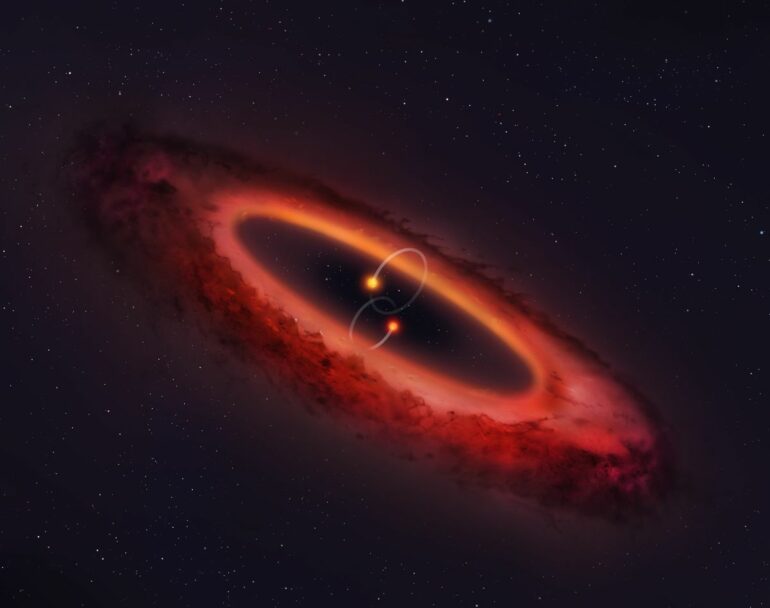Recently, the international team ALMA Survey of Orion Planck Galactic Cold Clumps (ALMASOP) led by Prof. Liu Tie from Shanghai Astronomical Observatory (SHAO) of the Chinese Academy of Sciences conducted a high-resolution investigation on 72 dense cores in the Orion Giant Molecular Clouds (GMCs) with the Atacama Large Millimeter/submillimeter Array (ALMA), and discovered a forming quadruple-star system within one core. The result of ALMA observation also revealed ribbon-like dust structures and intricate molecular outflows.
Previously, a widely separated quadruple-star system in its early stage was reported in the journal Nature. The quadruple-star system discovered in this new study, published in The Astrophysical Journal Letters, exhibits more compaction between members and more complex star formation activities, providing a diverse perspective for understanding the formation of multiple-star systems.
It is a well-known fact that approximately half of the stars in the galaxy reside in systems with two or more stars. Knowledge of how multiple-star systems form is essential for building complete theories of star and planet formation. All stars form in the densest gas region of the molecular cloud known as the “dense core.”
Previous observation has shown that the more “star babies” are in a stellar system, the smaller the proportion they take up in the whole. For higher-order stellar systems with more than two star-members, how they are formed in dense cores remains ambiguous due to insufficient observations.
Extant models suggest that multiple-star systems form via fragmentation of a cloud core in its early evolution. To explore the origin of multiple-star systems, the ALMASOP team conducted a high-resolution investigation on 72 young and cold cores in the Orion GMCs. Scientists observed the thermal emission of dust at a wavelength of 1.3 mm. They discovered a quadruple protostellar system in G206.93-16.61E2, a dense cold core located at 1,500 light-years from Earth within the Orion B GMC. The system consists of four members: two protostars, and two pre-stellar gas condensations that may also form low-mass stars in future.
Scientists discovered that the largest separation of the four members in the system is only 1,000 astronomical units. “The exceptional compactness and close-proximity of this system is a fascinating discovery. The analysis suggests that this system is very likely to form a gravitationally bound quadruple star system in the future,” said Ph.D. Luo Qiuyi at SHAO and the first author of the study. Scientists also discovered several ribbon-like elongated structures in the dust emissions, tightly binding the four members together and extending outward.
To discover the role of the continuum ribbons, scientists compared a similar quadruple system in a numerical simulation with the observational result. They revealed that the extending continuum ribbons can act as conveying funnels, transporting gas materials from the outer envelope/core down to the protostars, and connecting the newborn member stars as gas bridges.
“The simulation supports that these ribbons can serve as large-scale accretion streamers. Thus, the two gas condensations in the system have the potential to form a star relying on the feeding of these continuum ribbons,” explained Prof. Liu. “The accretion streamers could also fragment, and further form new stars.”
In addition, the observations revealed intricate gas outflows driven by the protostars in the system, potentially viewed from a pole-on perspective. In the crowded birthplace environment, some materials supplied from accretion flows are lost via outflows, which might have an impact on the evolution of their system.
“We do not have an explanation of how the gas outflows propagate as they might be entangled with gas accretion processes of system members. This study highlights the complicated interactions among members in a forming higher-order star system,” commented Ph.D. Luo.
This study provides compelling evidence for the formation of a quadruple system. Future exploration utilizing ALMA holds the promise of unveiling more details, propelling the understanding of the journey of multiple-star system formation.
More information:
Qiu-yi Luo et al, ALMA Survey of Orion Planck Galactic Cold Clumps (ALMASOP): A Forming Quadruple System with Continuum “Ribbons” and Intricate Outflows, The Astrophysical Journal Letters (2023). DOI: 10.3847/2041-8213/acdddf
Provided by
Chinese Academy of Sciences
Citation:
Astronomers discover a forming quadruple-star system (2023, August 9)



